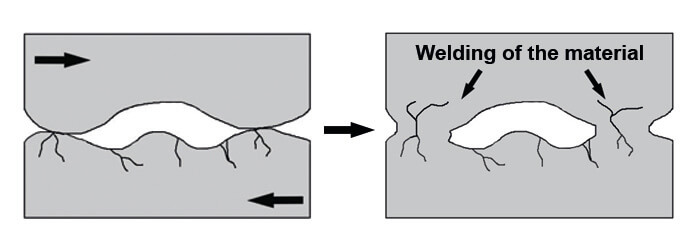


What is adhesive wear?
Adhesive wear is the result of the transfer of material from one surface to another and typically occurs in poorly lubricated sliding movements. Abrasion occurs on the material, cracks can appear on the surface and, in the worst case, the two friction partners can weld. This can result in considerable damage to the machine or even total failure of the system.
Another form of wear is abrasive wear.
Causes of adhesive wear
If there is insufficient sliding lubrication, there is an interaction between the unevenness or surface peaks of metal. In this case, a strongly adhesive interface can lead to "cold welding".
There are two basic factors that favour adhesive wear:
- The tendency of different types of materials to form solids or compounds on contact
- The general cleanliness of the surfaces that interact with each other
Apart from this, there are several other influencing factors that should be taken into account. The additive package and film thickness of the lubricant, the size of the components that define the equipment and certain operating parameters such as load and speed are also essential.
There is a variety of causes that lead to this unwanted contact of the surfaces and they can be roughly reduced to four main driving forces:
- Extreme or insufficient load
- Elevated temperatures and extreme pressure
- Acceleration or deceleration in the load range
- Excessive moisture in the load area
As mentioned earlier, sufficient lubricant film thickness and a good additive package help to counteract the problems of loading. A good understanding of how to operate the equipment and control peak loads as well as temperatures is also necessary to reduce this damage. The most common components directly affected by adhesive wear include rolling bearings, cylinders, gears and pistons.

Development of adhesive wear
Adhesive wear usually develops slowly and over a longer period of time. First, slight signs of wear appear, then moderate wear and finally severe wear.
Slightly adhesive wear occurs during the initial, minor wear of the surfaces and may be perceived as polishing. This wear may occur during the machine's break-in period. This early wear is often not visible to the eye, but is often detected during further inspection of the small surface cracks. It is important to notice the early signs of this wear pattern to prevent major damage.
Moderate wear of the material is visibly noticeable and often forms dark coloured lines or marks on the component. Due to the thermal nature of the wear occurring at this stage, some blue discolouration of the machine surface may also become apparent. It is important to follow the development of wear at this stage and to make a plan for the near future to solve this problem during the downtime of the machine.
Severe adhesive wear should be avoided at all costs. At this stage of wear, metal abrasion begins to increase strongly and to accumulate on the surface, giving it a "smeared" appearance. This leads to more noticeable wear, cracked surfaces and pitting. If severe adhesive wear is detected, the risk of equipment failure is high. A plan should be made urgently to remove the unit from service and replace it as soon as possible.
Detection and analysis
It is imperative to identify the individual phases of the development of adhesive wear. There are different methods to confirm a suspicion through analyses.
Basic visual inspections of the friction partners are the easiest way to detect problems related to adhesive wear. This can be done, for example, whenever the equipment is out of service. In general, visual inspections can only detect adhesive wear in the later stages, as the extent of incipient wear is often smaller than the human eye can perceive.
Endoscope inspection is another visual analysis tool used to detect adhesive wear. This advanced visual inspection provides much more detail about any associated problems and gives much earlier insight into the development process of adhesive wear. The use of this analysis tool is often triggered in response to a detected problem during predictive maintenance, but can also be used as a stand-alone tool during planned downtime.
Oil analysis can also help in the detection of adhesive wear. While early detection of adhesive wear is usually not possible due to the limited release of surface material, there are additional parameters in oil analysis that can provide indications of adhesive wear. One specific parameter to monitor is the concentration of wear and friction control additives. Although this task is sometimes difficult, as certain elements can appear in the system as both additives and impurities, it can still be considered useful. If there is a deep understanding of the system in question and of oil analysis in general, deviations from the optimum condition can be detected and possible causes of the problem can be uncovered.
Prevention of adhesive wear
Adhesive wear is usually caused by overloading, underloading or incorrect lubricant selection. Identifying loading problems during the installation phase and using the right lubricant composition that takes into account the application, film thickness, temperature, surface loads and environment are good ways to minimise the occurrence of adhesive wear. In addition, early detection of moisture ingress, correction of alignment problems and proper monitoring of the installation through the aforementioned analytical methods provide additional support to reduce the likelihood of this problem to occur during operation.
Contact
